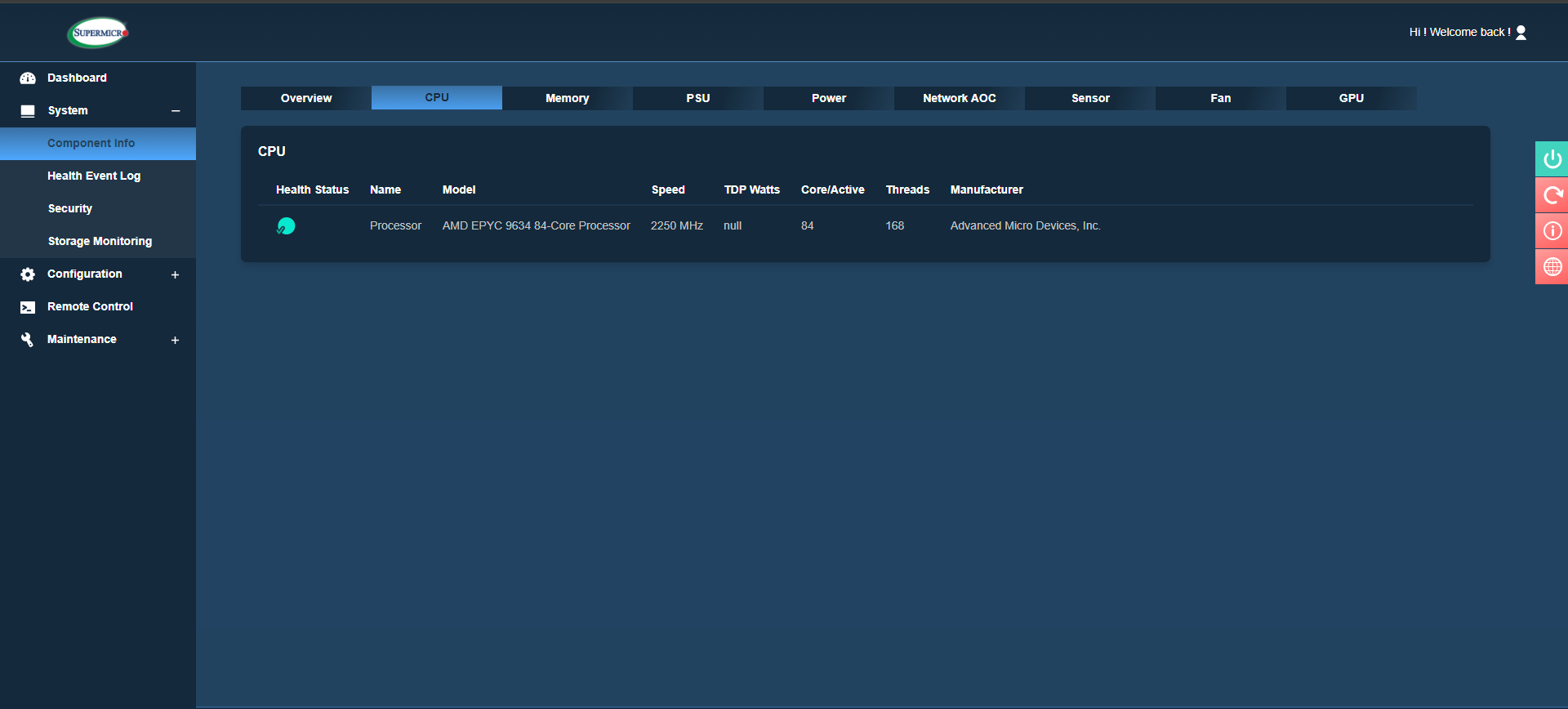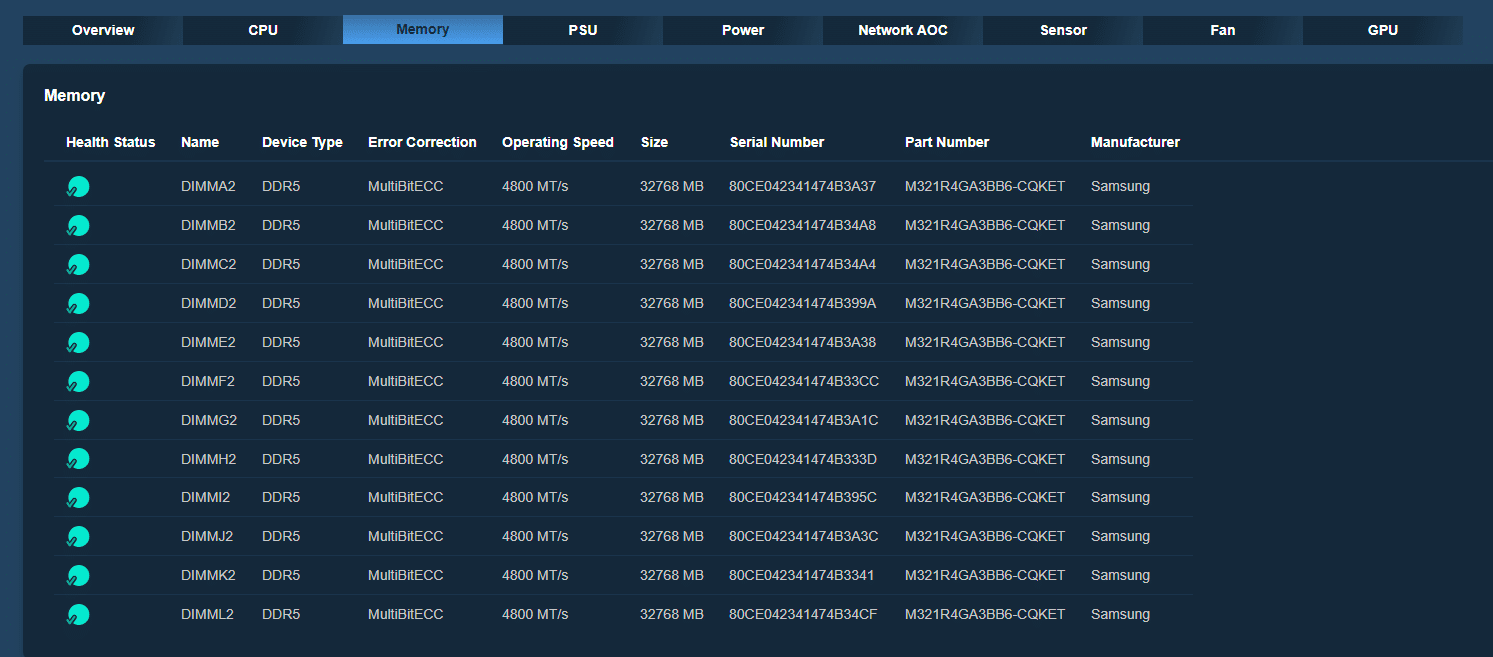Supermicro develops impressive and innovative storage solutions, and the ASG-1115S-NE316R is no exception. It is a single-socket EPYC 9004 series server with up to 16 hot-swap E3.S Gen5 SSDs in a 1U chassis.
Supermicro develops impressive and innovative storage solutions, and the ASG-1115S-NE316R is no exception. It is a single-socket EPYC 9004 series server with up to 16 hot-swap E3.S Gen5 SSDs in a 1U chassis.
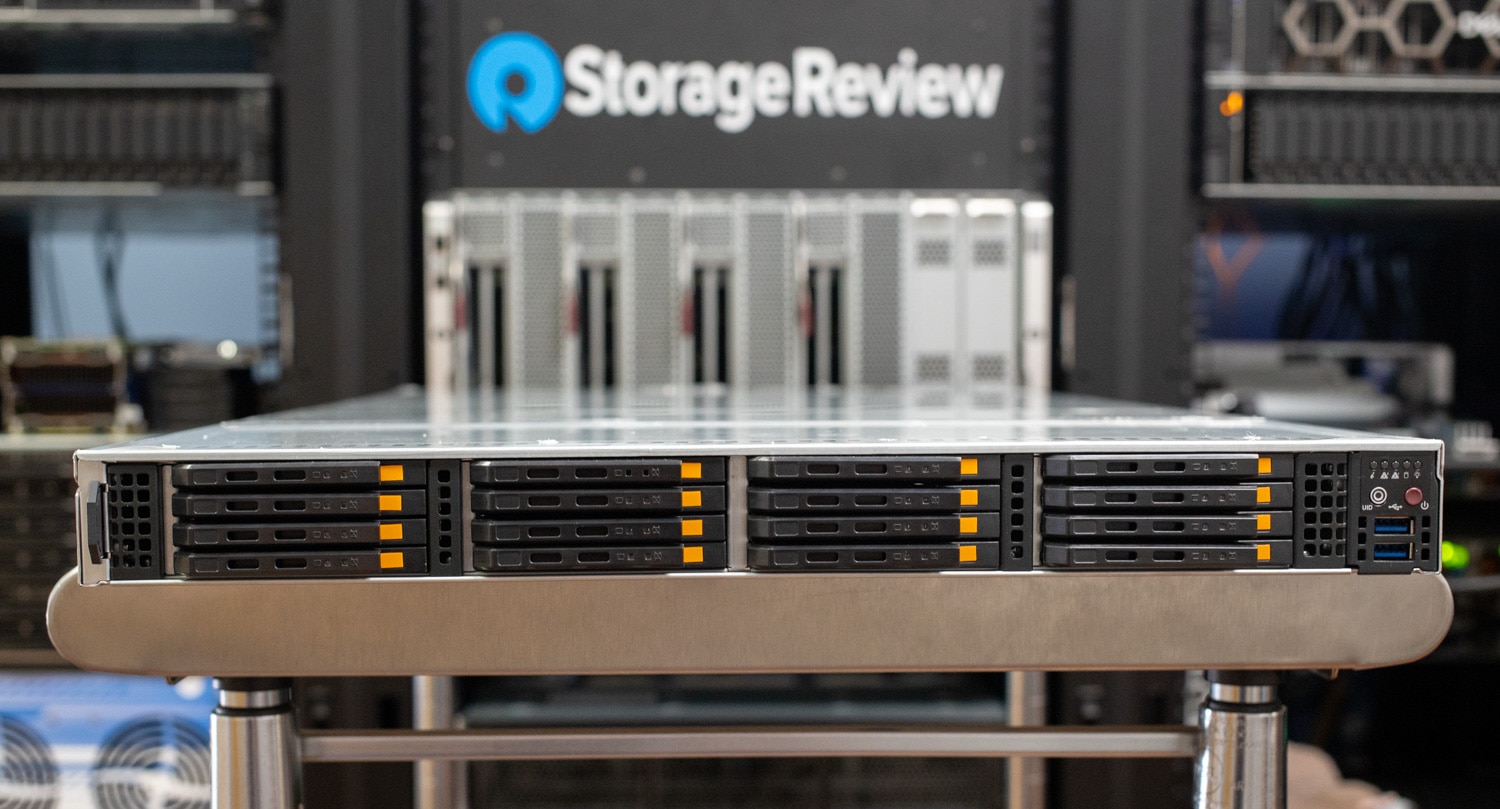
Supermicro Storage A+ ASG-1115S-NE316R Front Bays
Most enterprise SSD flash vendors are investing in the EDSFF form factors for Gen5 SSDs. In the enterprise, this typically means E3.S is the form factor of choice, where hyperscalers tend to lean toward E1.S. U.2/U.3 has lost momentum, as there are few Gen5 options. As such, this platform from Supermicro enables a storage-dense configuration, supporting up to 16 E3.S SSDs, without compromising the PCIe expansion options out the back of the chassis.
Fully populated, this chassis still supports 64 PCIe lanes for rear I/O across two Gen5 x16 OCP slots and two Gen5 x16 FH PCIe slots. Supermicro includes two M.2 slots compatible with 80mm and 110mm SSDs for onboard boot capacity. This chassis gives you the perfect platform to build a storage-dense server around the AMD Epyc SP5 socket.
Supermicro Storage A+ ASG-1115S-NE316R Design and Build
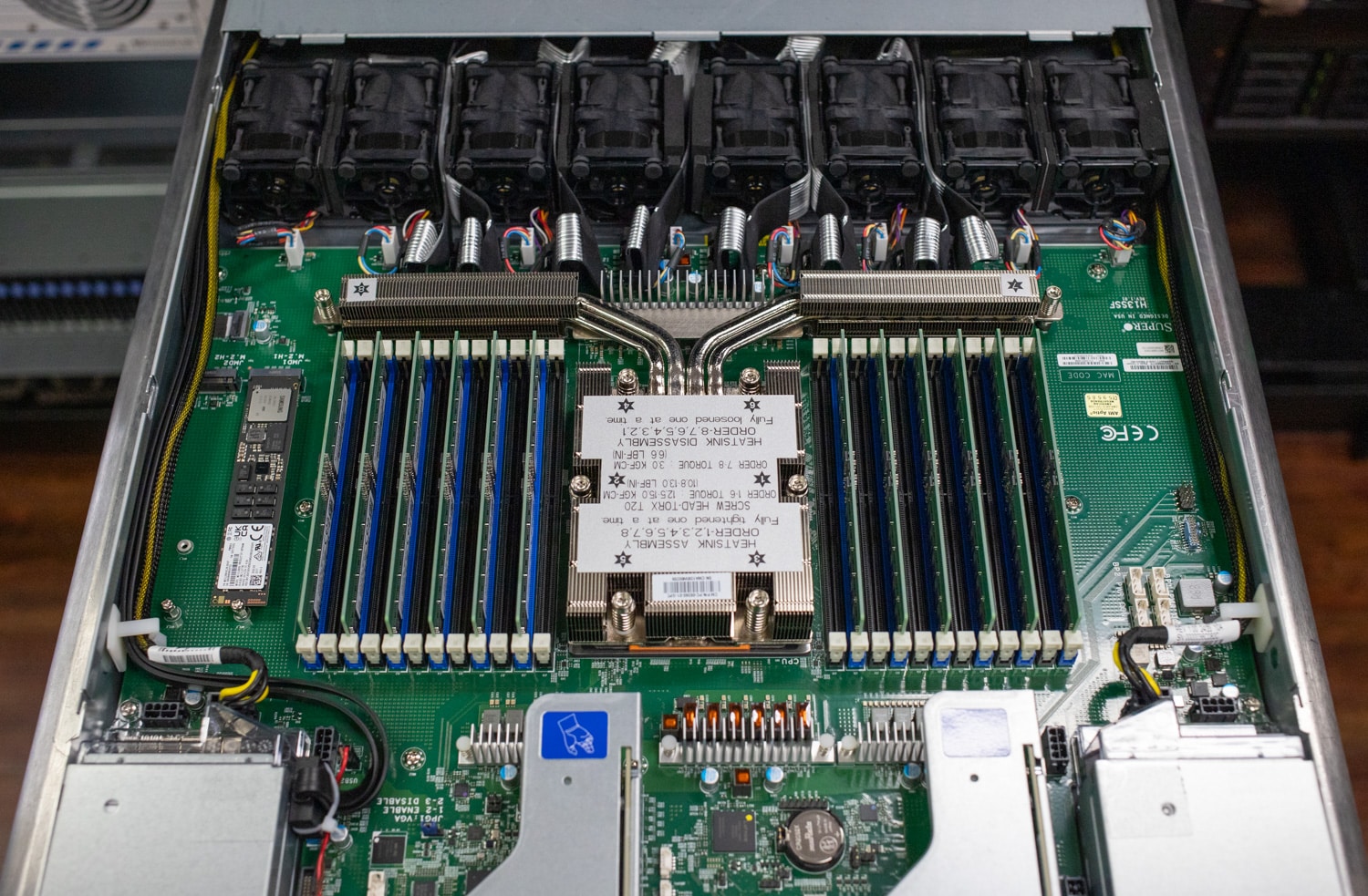
Supermicro Storage A+ ASG-1115S-NE316R Internal Layout
The ASG-1115S-NE316R is a single-socket server with up to 24 DDR5 DIMMs and 2 M.2s on the board with support for up to 6TB of memory and up to 96 cores. Visually striking is the branched-out CPU cooler near the center of the board. We’ve seen this in some other servers recently. This design gets more surface area to the CPU cooler, allowing it to offset more heat in such a small package, which is increasingly difficult in air-cooled 1U servers.
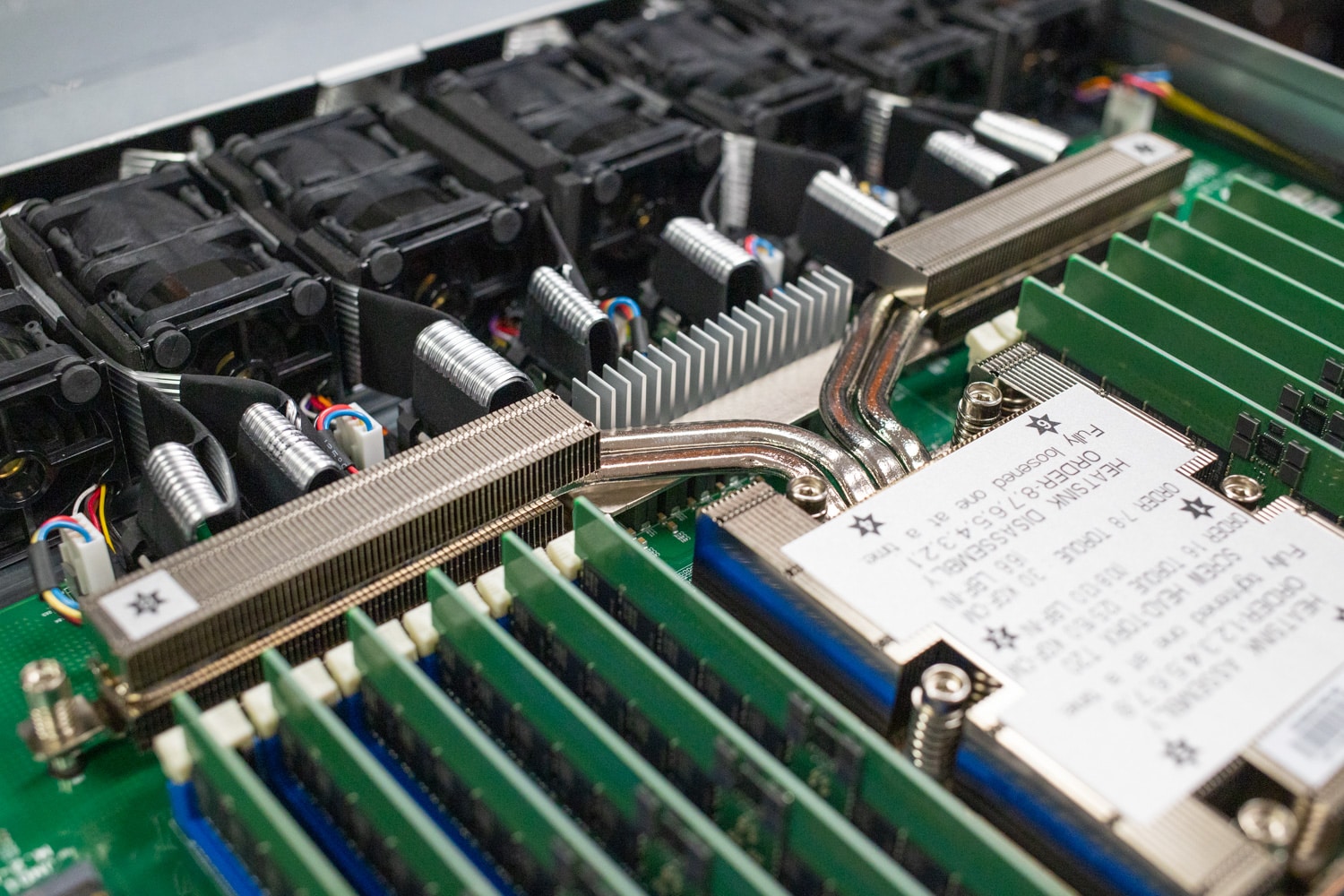
Supermicro Storage A+ ASG-1115S-NE316R CPU Heatsink
The rest of the cooling package mainly consists of 8 sets of double-stacked fans that pull air around the drive bays, force it over the heatsink and RAM, and then throughout the rest of the chassis, exhausting out the rear.
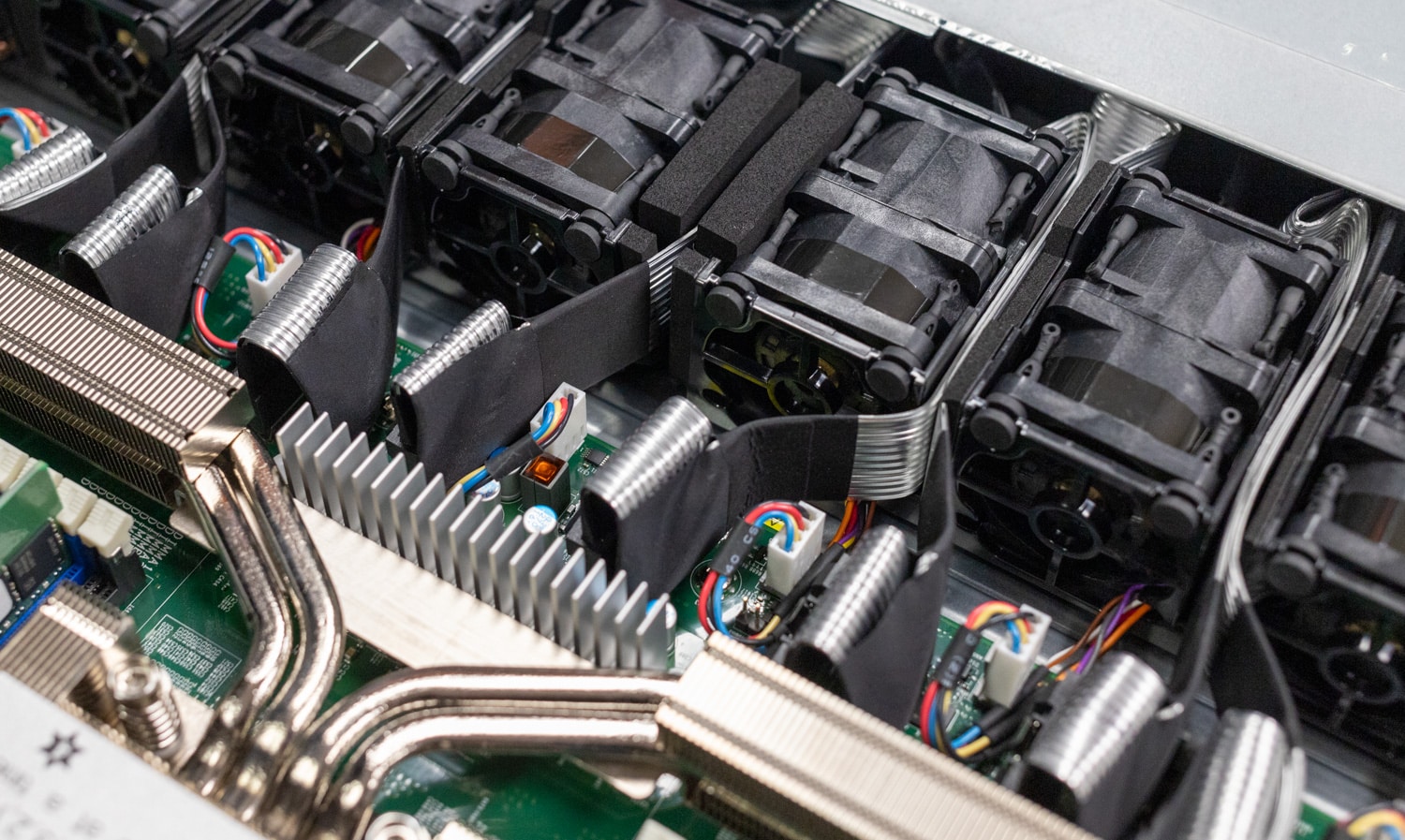
Supermicro Storage A+ ASG-1115S-NE316R Fans
Memory-wise, the ASG-1115S-NE316R has 24 slots for DDR5 ECC. The config for this review came with 384GB of DDR5 comprised of 12 sticks of 32GB Samsung DDR5 ECC running at 4,800 Mbps.
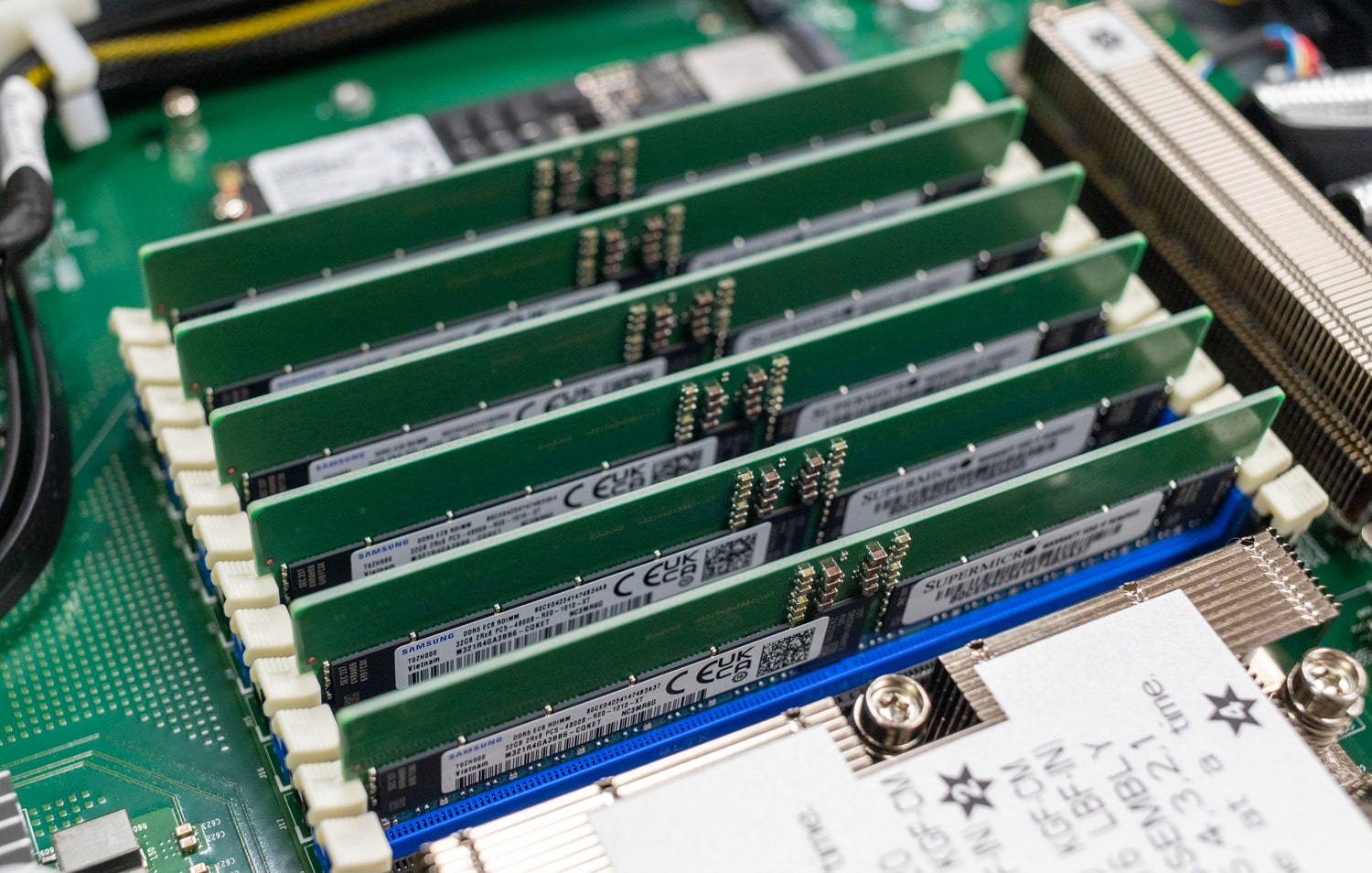
Supermicro Storage A+ ASG-1115S-NE316R DRAM Bank
Another nice touch on this server is the use of toolless caddies for the E3.S drives, which allow drives to be easily prepared or swapped out. It’s great to see toolless methods of drive retention, regardless of the application.
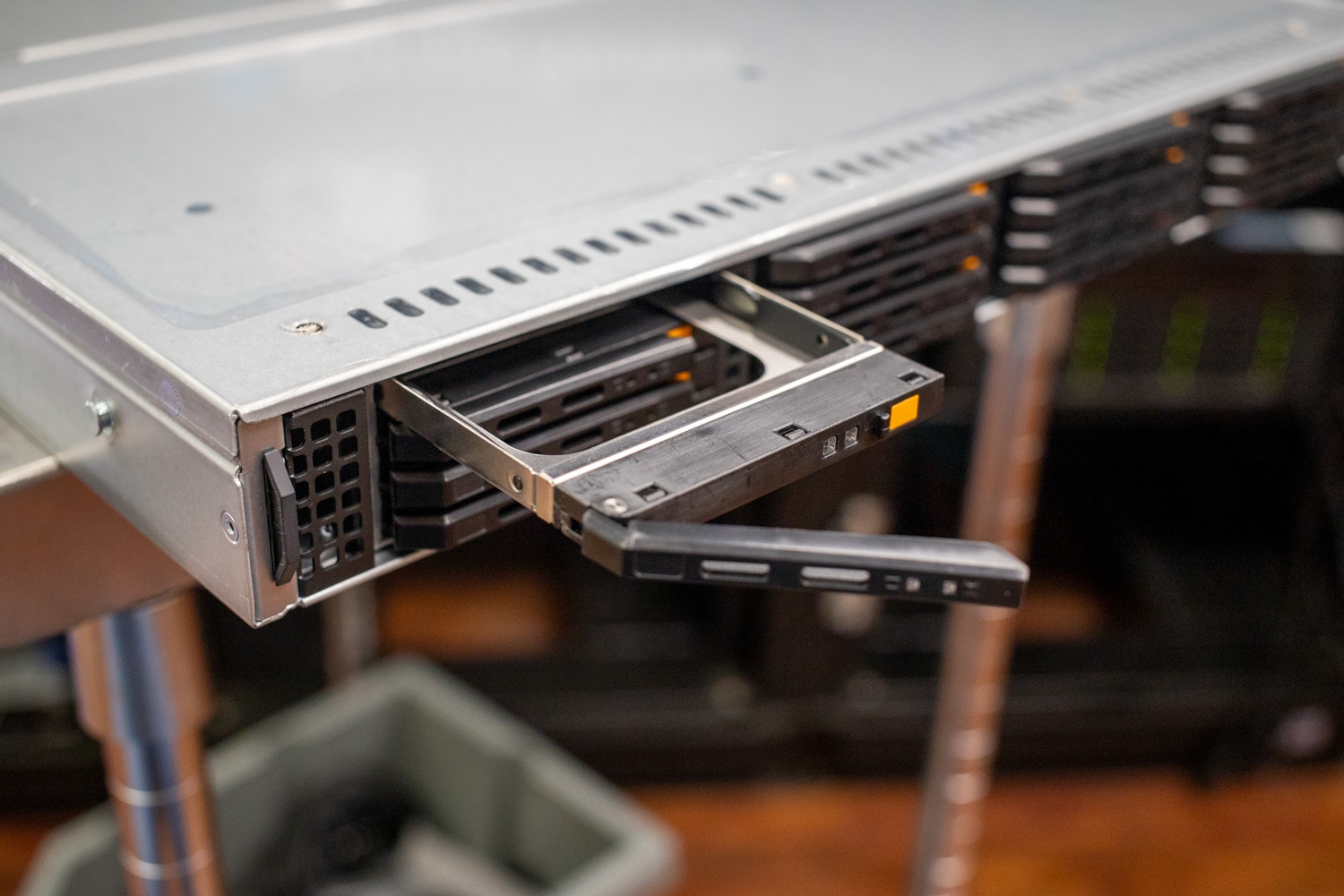
Supermicro Storage A+ ASG-1115S-NE316R Toolless Drive Caddies
On the rear of the server, we can see the four different expansion slots, which consist of two PCIE 5.0 16x FH slots and two PCIE 5.0 16x AIOM slots. Currently, in the FH PCIe 5.0 slots, there is a Mellanox ConnectX-6 DX 200G NIC in each slot. The other IO is pretty standard, with a single RJ45 for the IPMI, 2 USB 3.0 ports, and a VGA port.
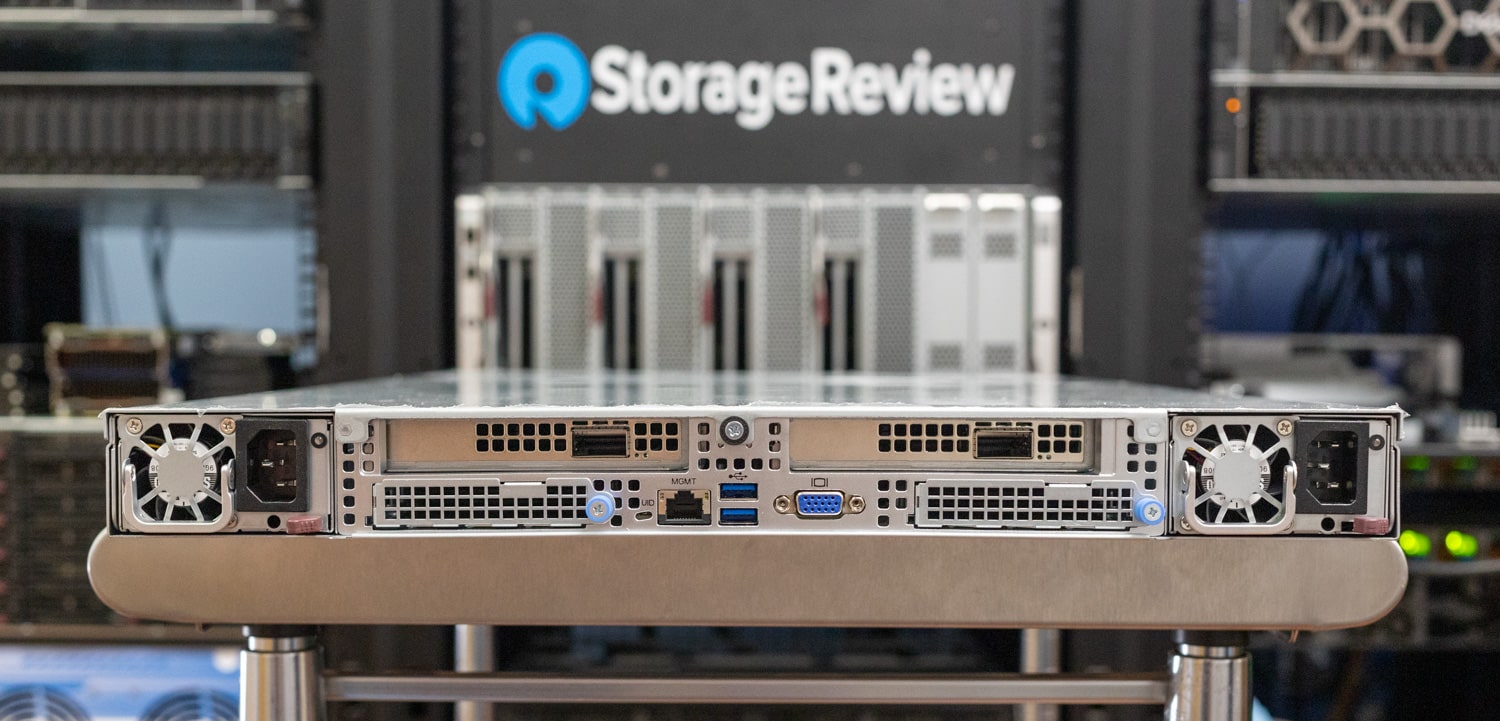
Supermicro Storage A+ ASG-1115S-NE316R Rear
What’s interesting about the rear IO is that all the ports are on a daughterboard that links to the motherboard with a single connector. This helps in the motherboard design by eliminating the need for a section sticking out between the AIOM slots, which would be a waste of material in the manufacturing process.
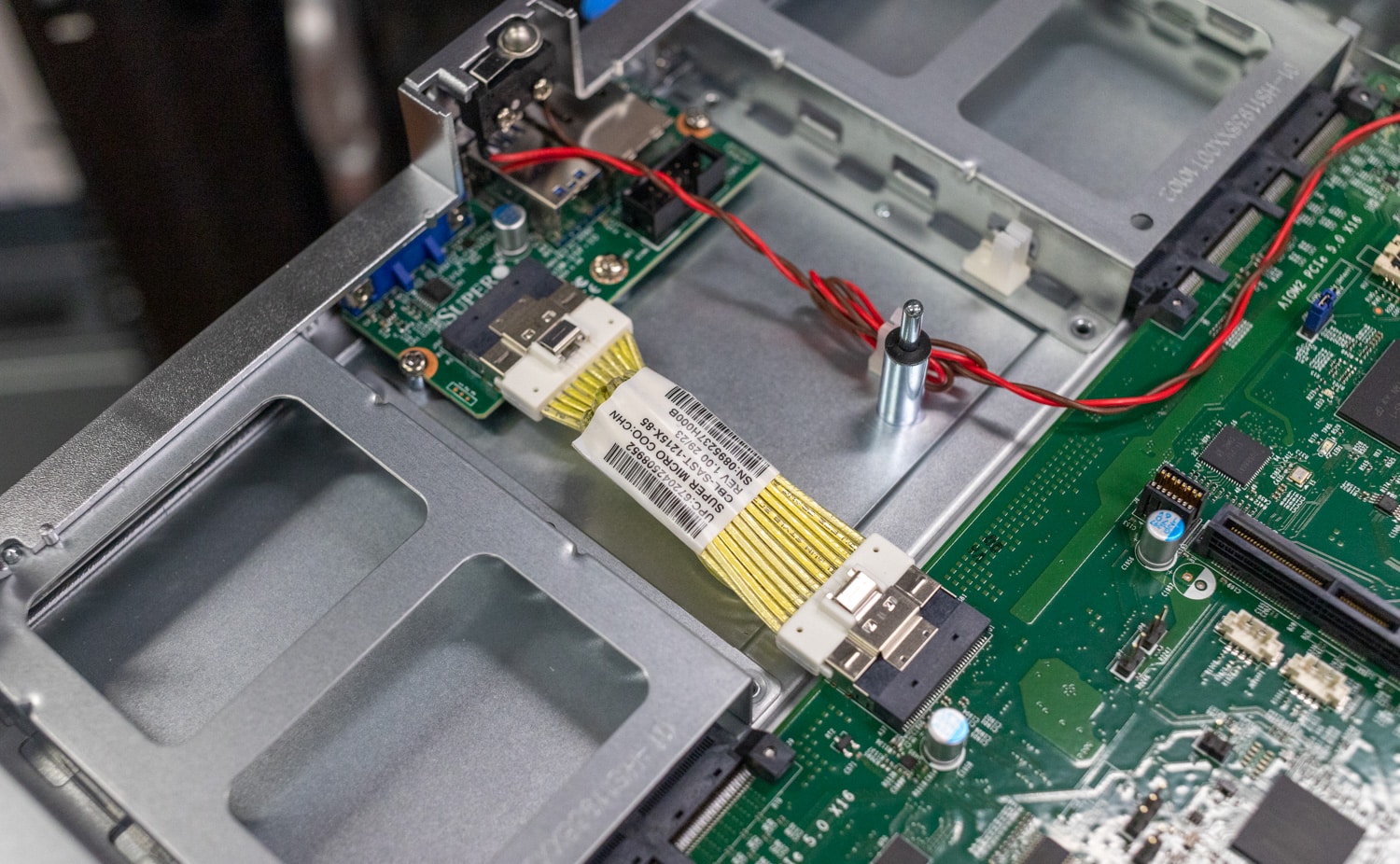
Supermicro Storage A+ ASG-1115S-NE316R Rear IO Daughter Board
ASG-1115S-NE316R Specifications
| ASG-1115S-NE316R | |
|---|---|
| CPU | Single Socket SP5 Epyc 9004 Series Up to 96C/192T Supports 200W-300W TDP CPUs (Air Cooled) |
| RAM | 24 DIMM slots up to 6TB ECC DDR5 RDIMM/LRDIMM @4800MT/s |
| Storage / Drive Bays |
|
| Expansion Slots |
|
| Input / Output |
|
| Front Panel |
|
| Power Supplies | 2x 1600W Titanium Power Supplies
|
| Motherboard | Super H13SSF |
| Chassis | 1U Rackmount CSE-126E32-R1K62P |
| Management |
|
| Security | Hardware:
Software:
|
| Operating Environment |
|
The complete spec sheet can be found here.
Supermicro Storage A+ ASG-1115S-NE316R Management
The ASG-1115S-NE316R utilizes the IPMI interface for out-of-band management (OOBM), which is pretty uniform across modern Supermicro systems. The IPMI allows remote management while also showing the status of individual components.
The IPMI helps diagnose hardware faults quickly and simplifies hardware setup and management. Using the remote console removes the need to tote a monitor and peripherals to the server and allows you to do it remotely. The remote console also has an option to mount virtual media for OS installation, software installation, and updates.
Performance
Our Supermicro Storage A+ ASG-1115S-NE316R review unit is configured with the following:
- CPU: 84-core EPYC 9634
- RAM: 384GB DDR5 (12x 32GB DIMMs)
- SSD: 1TB Samsung PM9A3
- 2x Mellanox ConnectX-6 DX 100G
- Windows Server 2022
To set up some comparison, we will add benchmark data for the 96-core Genoa-X and 128-core Bergamo from our AMD Bergamo/Genoa-X Review. These are meant to show scale in the AMD EPYC CPU line; this is the first server platform in the lab for review with the EPYC 9634.
TYAN SX TS70AB8056
- 96-core EPYC 9684X
- 512GB DDR5
TYAN SX TS70AB8056
- 128-core EPYC 9754
- 512GB DDR5
Blender OptiX 3.6
First up is Blender OptiX–an open-source 3D modeling application. This benchmark was run using the Blender Benchmark CLI utility. The score is samples per minute, with higher being better. The Version 3.6 test has been around for some time, and we do have results for all of the comparison machines here. As expected, the 84C EPYC in the Supermicro held up pretty well and performed just behind the 96-core 9684X, which performed just behind the 128-core 9754.
| Blender 3.6 CPU | Supermicro ASG-1115S-NE316R (84C EPYC 9634, 384GB DDR5) | TYAN SX TS70AB8056 (96C EPYC 9684X, 512GB DDR5) | TYAN SX TS70AB8056 (128C EPYC 9754, 512GB DDR5) |
|---|---|---|---|
| Monster | 702.590 | 879.580 | 1031.495 |
| Junkshop | 483.502 | 605.446 | 704.168 |
| Classroom | 341.717 | 421.318 | 506.666 |
Blender OptiX 4.0
Since we reviewed the Bergamo and Genoa-X chips a while back, we don’t have results for Blender 4.0, which came out fairly recently. Because of this, we only have results for the Supermicro with the 84C EPYC 9634 in the 4.0 CPU test. For this, EPYC 9634 scored 673.21 points on Monster, 475.17 on Junkshop, and 342.06 on Classroom.
| Blender 4.0 CPU | Supermicro ASG-1115S-NE316R (84C EPYC 9634, 384GB DDR5) |
|---|---|
| Monster | 673.21 |
| Junkshop | 475.17 |
| Classroom | 342.06 |
Blackmagic RAW Speed Test
We have been running Blackmagic’s RAW speed test, which tests video playback. This is more of a hybrid test that includes CPU and GPU performance for real-world RAW decoding. Since this server doesn’t have a GPU, we don’t have any CUDA results, but it hit 131 FPS with the CPU.
| Blackmagic RAW Speed Test (Higher is better) | Supermicro ASG-1115S-NE316R (84C EPYC 9634, 384GB DDR5) |
|---|---|
| 8K CPU | 131 FPS |
Blackmagic Disk Speed Test
The Blackmagic Disk Speed Test is another test for which we only have results for the Supermicro. This test runs a 5GB sample file for read and write speeds. With this test, we saw read speeds of over 3 GB/s and almost 1.5 GB/s on the Supermicro’s 1TB Samsung PM9A3 M.2 SSD.
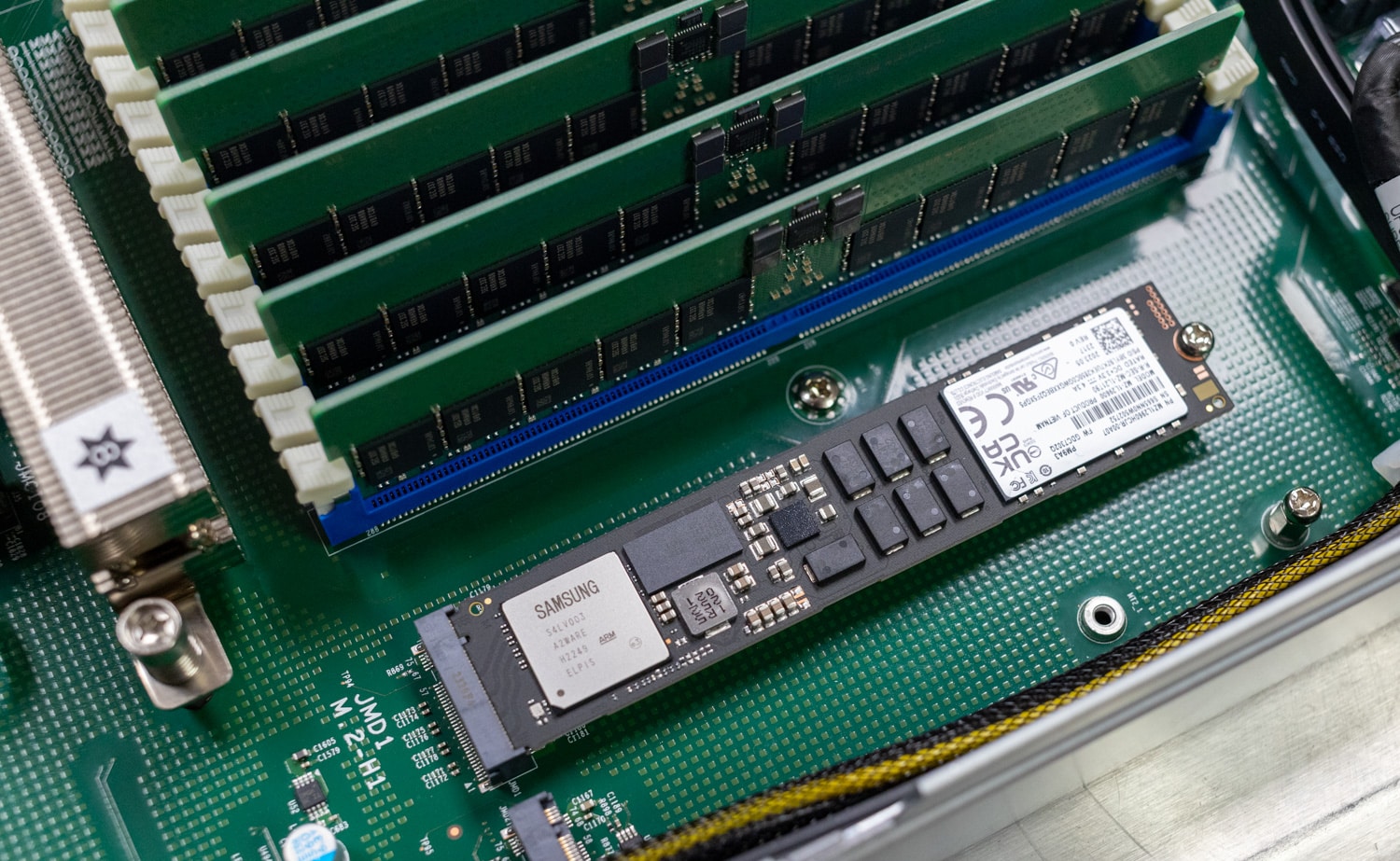
Supermicro Storage A+ ASG-1115S-NE316R Boot Drive
| Blackmagic Disk Speed Test (Higher is better) | Supermicro ASG-1115S-NE316R (84C EPYC 9634, 384GB DDR5) |
|---|---|
| Write | 1,415.1 MB/s |
| Read | 3,031.0 MB/s |
Cinebench R23
Maxon’s Cinebench R23 is a CPU rendering benchmark that utilizes all CPU cores and threads. We ran it for both multi- and single-core tests. Higher scores are better. Here are the results for all of the EPYC chips. While we see an expected gap between them for the multi-core portion, the single-core portion only varies by eight points between 84c and 96c. On the 128c, it was behind the other two by 203 points to the 96c and 211pts behind the 84c.
| Cinebench R23 | Supermicro ASG-1115S-NE316R (84C EPYC 9634, 384GB DDR5) | TYAN SX TS70AB8056 (96C EPYC 9684X, 512GB DDR5) | TYAN SX TS70AB8056 (128C EPYC 9754, 512GB DDR5) |
|---|---|---|---|
| CPU (Multi-Core) (Points) | 81,148 | 93,720 | 103,876 |
| CPU (Single-Core) (Points) | 1,309 | 1,301 | 1,098 |
| MP Ratio | 61.99x | 72.04X | 94.65x |
Cinebench 2024
Maxon’s Cinebench 2024 is a CPU and GPU rendering benchmark that utilizes all CPU cores and threads. We ran it for both multi- and single-core tests. Since this configuration does not have a GPU, we do not have those numbers. Higher scores are better. Again, we only have results for the ASG-1115S-NE316R in this test.
| Cinebench 2024 | Supermicro ASG-1115S-NE316R (84C EPYC 9634, 384GB DDR5) |
|---|---|
| CPU (Multi-Core) (Points) | 4,913 |
| CPU (Single-Core) (Points) | 81 |
| MP Ratio | 60.47x |
Geekbench CPU Benchmark
Geekbench 6 is a cross-platform benchmark that measures overall system performance. However, looking at the single-core vs. multi-core and the OpenCL benchmark would be interesting. Higher scores are better. Again, we only looked at the CPU results, as no GPU is installed inside this server. Similar to what we saw for Cinebench 2023, the single-core performance between the EPYC 9634 in the Supermicro and the EPYC 9684X was very close and a more significant gap to the EPYC 9754. The multi-core performance between the EPYC 9634 and EPYC 9684X was also pretty tight, with 22,868 on the 9634 and 21,329 on the 9684X, but again a more significant gap to the 9754 with 18,683.
You can find comparisons to any system you want in the Geekbench Browser.
| Geekbench 6 | Supermicro ASG-1115S-NE316R (84C EPYC 9634, 384GB DDR5) | TYAN SX TS70AB8056 (96C EPYC 9684X, 512GB DDR5) | TYAN SX TS70AB8056 (128C EPYC 9754, 512GB DDR5) |
|---|---|---|---|
| CPU Benchmark – Single-Core | 2,055 | 2,093 | 1,738 |
| CPU Benchmark – Multi-Core | 22,868 | 21,329 | 18,683 |
y-cruncher
y-cruncher is a multi-threaded and scalable program that can compute Pi and other mathematical constants to trillions of digits. Since its launch in 2009, it has become a popular benchmarking and stress-testing application for overclockers and hardware enthusiasts. Results-wise, we only have numbers for 1 Billion and 10 Billion for the 9684X and 9754, but on the 9634 EPYC, we have results from 1 Billion to 50 Billion. Surprisingly, the Supermicro pulled to the front with the 9634 and only 7.274 sec for 1 Billion and 71.336 sec for 10 Billion.
| y-cruncher (Total Computation time) (lower is better) | Supermicro ASG-1115S-NE316R (84C EPYC 9634, 384GB DDR5) | TYAN SX TS70AB8056 (96C EPYC 9684X, 512GB DDR5) | TYAN SX TS70AB8056 (128C EPYC 9754, 512GB DDR5) |
|---|---|---|---|
| 1 Billion digits (Seconds) | 7.274 sec | 10.296 sec | 9.568 sec |
| 2.5 Billion digits (Seconds) | 17.055 sec | N/A | N/A |
| 5 Billion digits (Seconds) | 34.336 sec | N/A | N/A |
| 10 Billion digits (Seconds) | 71.336 sec | 72.377 sec | 80.171 |
| 25 Billion digits (Seconds) | 196.695 sec | N/A | N/A |
| 50 Billion digits (Seconds) | 439.435 sec | N/A | N/A |
7-Zip Compression
The popular 7-Zip utility has a built-in memory benchmark that demonstrates CPU performance. In this test, we run it at a 128MB dictionary size when possible. Again, we only have results for the ASG-1115S-NE316R for this test.
| Supermicro ASG-1115S-NE316R (84C EPYC 9634, 384GB DDR5) | |
|---|---|
| Compressing | |
| Current CPU Usage | 3,574% |
| Current Rating/Usage | 5.755 GIPS |
| Current Rating | 205.670 GIPS |
| Resulting CPU Usage | 3,572% |
| Resulting Rating/Usage | 5.733 GIPS |
| Resulting Rating | 204.758 GIPS |
| Decompressing | |
| Current CPU Usage | 3,810% |
| Current Rating/Usage | 5.753 GIPS |
| Current Rating | 219.191 GIPS |
| Resulting CPU Usage | 3,803% |
| Resulting Rating/Usage | 5.779 GIPS |
| Resulting Rating | 219.768 GIPS |
| Total Rating | |
| Total CPU Usage | 3,687% |
| Total Rating/Usage | 5.756 GIPS |
| Total Rating | 219.768 GIPS |
Conclusion
The Supermicro ASG-1115S-NE316R is a dense EPYC platform that packs a lot of potential into 1U. On the CPU performance side, we saw some interesting numbers between the 84-, 96-, and 128-core chips, with the 128-core 9754 performing lower in some workloads and the 84-core 9634 pulling to the front. Now more than ever, it’s essential to understand workloads and pair CPUs appropriately.
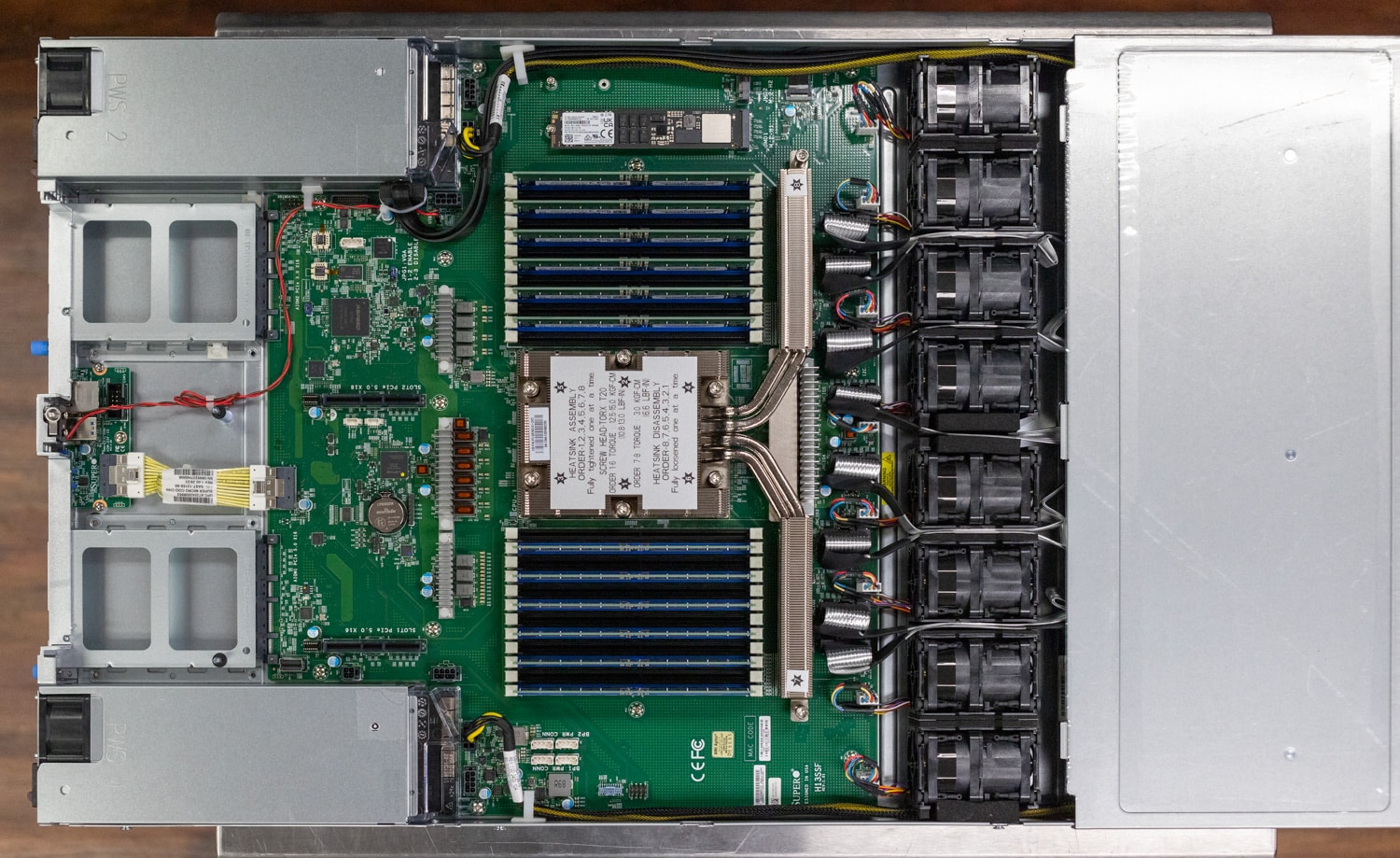
Supermicro Storage A+ ASG-1115S-NE316R Chassis
Regarding storage servers, the Supermicro Storage A+ ASG-1115S-NE316R stands out as a modern entry that’s efficiently laid out and well specced to handle whatever the software application installed on top requires. The E3.S Gen5 bays also stand out, delivering six more bays than usual in a 1U sever with U.2 bays. Critically important, Supermicro didn’t skimp on the back IO either, giving users four options to leverage on that front.
In this review, we’ve focused on system performance on the storage front. In a subsequent article, we’ll dive more deeply into the storage performance story when stuffed full of high-performance Gen5 flash.
Supermicro ASG-1115S-NE316R Product Page.
Engage with StorageReview
Newsletter | YouTube | Podcast iTunes/Spotify | Instagram | Twitter | TikTok | RSS Feed

